Flower Calendar
Update:2025/3/28
- Plum blossoms
- Cherry blossoms
- Peonies
- Wisteria
- Azaleas
- Roses
- Hydrangeas
- Japanese Irises
- Sunflowers
- Cosmos
February
Plum Blossoms (ume)
Peak viewing time: Mid February
Access: Miyayamadai-2cho bus stop (Nankai Bus)
Visitors can enjoy about 1,400 ume trees representing 47 species.
March - April
Cherry Blossoms (sakura)
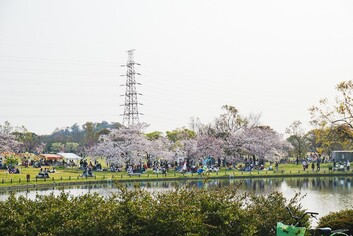 Daisen Park
Daisen Park
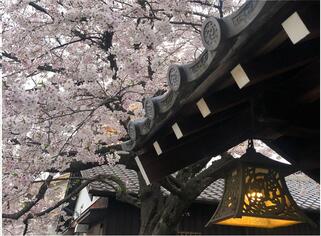 Chozenji Temple
Chozenji Temple
Peak viewing time: Late March to early April
- Daisen Park: Mozu station (JR Hanwa Line) or Daisen-cho bus stop (Nankai Bus. The central pond is surrounded by about 400 cherry blossom trees.
- Chozenji Temple: Sakaihigashi station (Nankai Koya Line). Roughly 30 trees that are over 30 years old.
- Nishihara Park: Togamikita station (Semboku Rapid Line). Consisting mostly of the popular variety Somei-yoshino, there are over 1600 cherry blossom trees planted here.
- Kozen Park: Takeshiro-daiguchi or Miyayama-dai nicho bus stop (Nankai Bus) from Izumigaoka station (Semboku Rapid Line). A park that’s not only famous for plum blossoms; there are also beautiful cherry blossom trees.
- Ohama Park: Sakai station (Nankai Line). A park famous for cherry blossoms from historical days.
- Ohasu Park: Izumigaoka station (Semboku Rapid Line). A park which takes its name from the Ohasu Pond which takes up a third of the total area of the park. You can enjoy the reflection of the fully bloomed cherry blossoms in the water.
- Shirasagi Park: Shirasagi station (Nankai Koya Line). A park with roughly 10,000 Japanese irises consisting of 150 species. However it is also famous for its cherry blossoms.
- Kamotani Park: Komyoike station (Semboku Rapid Line). The cherry blossoms planted along the Kaidagawa river are a sight worth seeing and is the venue for the local cherry blossom festival.
- Shinhinoo Park: Komyoike station (Semboku Rapid Line). A park located north of Komyoike station. Roughly 900 cherry blossom trees, including Somei-yoshino, Oshima-zakura and Sato-zakura.
- Miike Park: Miikeda-nicho bus stop (Nankai Bus) from Togamikita station (Semboku Rapid Line). Located in the southern part of Semboku New Town. You can see cherry blossoms at every turn and the peak season is incredibly beautiful.
Peonies (botan)
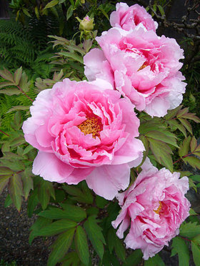
Peak viewing time: Mid to late April
Access: Daisencho bus stop (Nankai Bus)
Mid to end of April is the ideal time to view the approximately 500 peony plants. You can admire the peonies at Togendai garden, inspired by the Chinese Shangri-la design. The gorgeous red, pink, white and yellow peonies proudly signal the arrival of spring.
Wisteria (fuji)
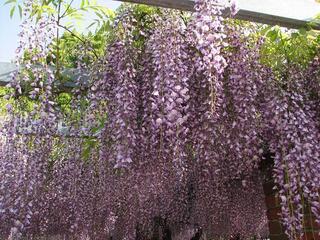
Peak viewing time: Late April
Access: 10min walk from Sakai station (Nankai Line)
Address: 4-3-50 Ohamakita-machi, Sakai-ku
The park has 3 areas with wisteria pergolas, and the wisteria that is north to a monkey breeding cage was planted around when Ohama Park was established in 1879, so it’s over 140 years old. From late April, when the flowers start blooming, it produces clusters of white flowers around 25cm in length. There are 2 other wisteria pergolas with light purple-coloured flowers.
May
Azalea (tsutsuji)
Peak viewing time: Late April
- Asakayama Greenway
Access: Asaka station (JR Hanwa Line), Asakayama station (Nankai Koya Line), Aisengakuen-mae bus stop (Nankai Bus)
Azalea is Sakai City’s official flowering bush. At Asakayama Greenway, every year in late April around 2,500 azalea bushes will reach peak bloom. Asakayama Greenway was originally part of Asakayama Water Filtration Plant. In 1937 azaleas were planted on this Water Filtration Plant for the public to enjoy, leading to them being widely loved and designated as the city’s official flowering bush. Why don’t you come enjoy the beautiful azaleas and also ponder such history?
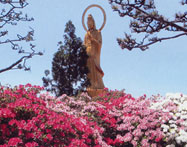
- Hounji Temple
Access: Imai bus stop (Kintetsu Bus) or Imaiminami bus stop (Nankai Bus)About 1,000 red, white, and pink hirado azaleas adorn the temple’s 3,333 square meter grounds. At the height of flower viewing season, over 1,000 people visit the temple every day.
Access: Funatoshita bus stop (Nankai Bus). The park is planted with about 7,000 flowering trees and shrubs, including Japanese cinnamon trees and azalea bushes.
- Mizugaike Pond
Access: Fukai station (Semboku Rapid Line). Colorful azaleas are planted near the pond’s banks.
Japanese Irises (kakitsubata)
Peak viewing time: Early to mid May
Place: Oizumi Ryokuchi Park
Access: Shinkanaoka station (Subway Midosuji Line)
Roses

Peak viewing time: Mid May to Early June; Early October to Early November
Access: Hamaderaekimae station (Hankai Tramway) or Hamaderakoen station (Nankai Line)
The garden greets visitors with the colorful splendor and noble fragrance of its 6,000 plants representing about 500 species, including both indigenous wild and modern rose species.
- Shinonome Park
Access: Sakai-shi station (JR Hanwa Line)
Modeled on a European promenade, the park is planted with 1,300 rosebushes representing 60 species.
June
Hydrangeas
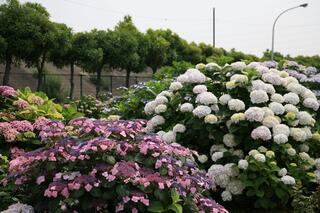
- Sambo Water Recycle Center
Peak viewing time: Late May to early June
Access: Matsuyayamatogawadori bus stop (Nankai Bus)
About 1,000 hydrangea plants bloom all at once each spring. Grounds open to the public in late May for their annual hydrangea festival.
Japanese Irises (hanashobu)
Peak viewing time: Early June
Access: Daisencho bus stop (Nankai Bus)
Irises bloom in elegance along the shores of Kakitsubataike Pond.
Access: Funatoshita bus stop (Nankai Bus)
Irises are planted near Funatoike Pond.
Access: Shirasagi station (Nankai Koya Line)
Visitors can enjoy 10,000 irises representing about 200 species.
Morning Glory (asagao)
Date: Mid-July to late August
Place: Daisen Park Japanese Garden
Access: Daisencho bus stop (Nankai Bus)
Come and see large flowered morning glories and other variations.
August
Sunflowers
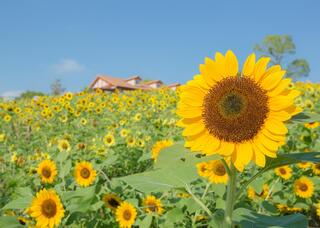
Peak viewing time: Until early August
Access: 20 minutes from Habesutono-oka bus stop (Nankai Bus) from Izumigaoka station (Semboku Rapid Line)
Come see the impressive 60,000 sunflowers! There will also be a sunflower photo contest, sunflower themed food menu and crafts classes.
October
Cosmos
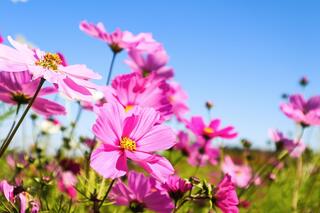
Peak viewing time: Late September to mid October
Access: 20 minutes from Habesutono-oka bus stop (Nankai Bus) from Izumigaoka station (Semboku Rapid Line)
About 500,000 cosmos plants flower on Harvest Hill. Across the suspension bridge is the village’s flower garden, about 4,000 square meters of lovely pink,red,and white flowers.
